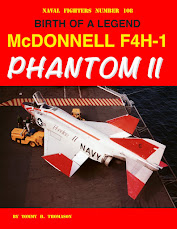This is a work in progress...
The AD-4 prototype, BuNo 122853, on 27 September 1949.
I've done a few posts on the AD-4W, the Airborne Early Warning Skyraider:
https://tailspintopics.blogspot.com/2018/06/ad-4w-skyraider.html
https://tailspintopics.blogspot.com/2019/11/douglas-ad-4waew1-and-sword-172-scale.html
https://tailspintopics.blogspot.com/2019/08/sword-172-douglas-ad-4w-skyraider.html
https://tailspintopics.blogspot.com/2021/12/sword-172-ad-4w-redux.html
https://tailhooktopics.blogspot.com/2019/11/douglas-ad-4waew1-antenna-configurations.html
I've also recommended three softcover monographs on the Skyraider with material of interest to the scale modeler: https://tailspintopics.blogspot.com/2011/10/ad-skyraider-modeling-notes.html
This is a summary of AD-4 variants (other than the AD-4W and one or two others that were not produced in quantity) and associated Bureau Numbers:
AD-4: Single-seat conventional attack
AD-4B: Single-seat
special stores (nuclear) attack: added external center pylon and Mk 8 tail fin recess
AD-4L: Winterized with deice boots on wing and empennage leading edge and propeller and windshield anti-icing
AD-4N: Three-place (no dive brakes) all-weather attack, ECM, and ASW
AD-4NA: All-weather mission equipment removed
AD-4NL: AD-4N with winterization
AD-4Q: Two-place radar location and jamming and provisions for target tow
Bureau Numbers
122853 AD-3 (AD-4 prototype)
123771 - 124006 AD-4 (123935 and 123952–124005 to AD-4L; 124006
to AD-5)
124037 - 124075 AD-4Q
124128 - 124156 AD-4N (124760 to AD-4NL)
124725 – 124760 AD-4N (All to AD-4NL)
125707 – 125741 AD-4N
125742 – 125764 AD-4NA
126876 – 127018 AD-4N (Most to AD-4NA)
127844 – 127853 AD-4 (127845-52 AD-4L)
127854 - 127872 AD-4 (127854-60, 127866, 127868-72 to AD-4B)
127873 – 127879 AD-4
127880 – 127920 AD-4N
(Most to AD-4NA)
128917 – 129016 AD-4 (128937-43 and 71-78 to AD-4B)
132227 – 132391 AD-4B
Skyraider kits other than AD-5 and AD-4W almost all represent the AD-6. The most notable difference between the late AD-4 and the AD-6—other than antennas and similar small details—were the stores pylons. This post illustrates the pylon differences: https://tailhooktopics.blogspot.com/2015/07/douglas-ad-1-skyraider-pylons.html
Another example of the flush AD-4 center-line store rack is provided here: https://tailspintopics.blogspot.com/2018/04/things-under-wings-va-195-kitchen-sink.html
The AD-4 configuration also changed during its production run. Most of the improvements were retrofitted to delivered airplanes as well. The two most significant were the addition of another 20 mm cannon in each outer wing panel just outboard of the fold joint and "armor". For the latter, see https://tailspintopics.blogspot.com/2013/07/ad-armor-all.html. Others included the exhaust glare shield addition, static-pressure source location, antenna changes, and wing-tip navigation light location. Nose flaps on the inside of the cowling were added effective with BuNo 123880; for a description of the nose flaps and their operation, see https://tailspintopics.blogspot.com/2011/10/ad-skyraider-modeling-notes.html
The AD-4 also predated the development of the Douglas high-speed fuel tanks. Some examples of these post-WW II fuel tanks are illustrated here: https://tailspintopics.blogspot.com/2016/09/things-under-wings-post-war-external.html
Even the single-seat AD-4 had provisions for radar. Some of the different types of radar pods that it and the multi-seat AD-4 attack variants could carry are illustrated here: https://tailspintopics.blogspot.com/2012/11/things-under-wings-radar.html
More to follow...










